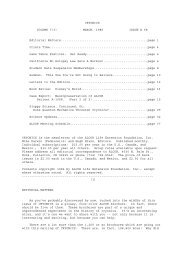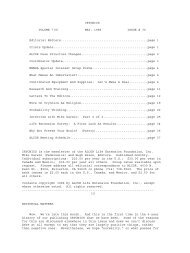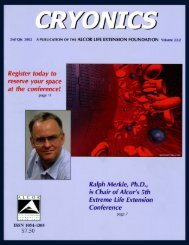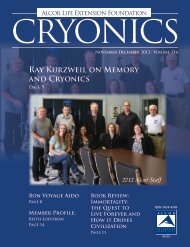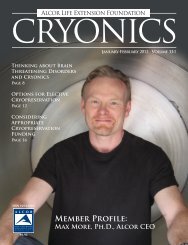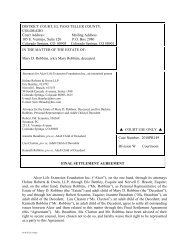Robert Ettinger - Alcor Life Extension Foundation
Robert Ettinger - Alcor Life Extension Foundation
Robert Ettinger - Alcor Life Extension Foundation
Create successful ePaper yourself
Turn your PDF publications into a flip-book with our unique Google optimized e-Paper software.
MEMBER PROFILE:<br />
Gregory Benford<br />
By Chana de Wolf<br />
It may come as no surprise that many<br />
cryonicists are avid science fiction fans.<br />
After all, cryonics is only necessary<br />
because we can’t already reverse aging and<br />
cure lethal diseases, so being on board to<br />
see the (possibly far-distant) future is requisite.<br />
Indeed, cryonics is somewhat of a<br />
science fiction staple, and such stories have<br />
inspired a select few readers to investigate<br />
real-world cryonics since the very first writers<br />
began freezing characters as a means to<br />
move futuristic plots forward. But one of<br />
those writers is a cryonicist himself, and his<br />
name is Gregory Benford.<br />
Benford, a professional research<br />
physicist since 1967 and professor at UC<br />
Irvine since 1971, also discovered cryonics<br />
through his love of science fiction, having<br />
read some of the early classics like The Door<br />
into Summer and The Age of the Pussyfoot. But<br />
he didn’t learn of <strong>Alcor</strong> until the Eaton<br />
Collection annual conference on science<br />
fiction in 1992. The theme that year was<br />
life extension and immortality in science<br />
fiction and fantasy—a topic which piqued<br />
Gregory participating in<br />
discussion at the National<br />
Academy of Sciences in 2010.<br />
____________________________________<br />
Gregory’s curiosity. Since the event was<br />
held at UC Riverside near the <strong>Alcor</strong> facility,<br />
he and fellow science fiction writer Joe<br />
Haldeman left the conference and took a<br />
tour. “[<strong>Alcor</strong>] impressed me with its realistic<br />
style of doing what one can now, despite<br />
the many unknowns,” Gregory remembers.<br />
“I was about 50 and realizing how the mortality<br />
wall was coming up on my horizon.<br />
That led me to write my longest novel,<br />
closely modeled on the <strong>Alcor</strong> experience.”<br />
That novel, Chiller, Gregory wrote<br />
while immersed in the study of cryonics.<br />
Under pressure from his publisher, Bantam,<br />
it was published under the pseudonym<br />
‘Sterling Blake’ in 1993 just after he had<br />
executed his arrangements with <strong>Alcor</strong>. Set<br />
around the UC Irvine campus and its medical<br />
school, the novel is based on <strong>Alcor</strong> and<br />
well-known figures in <strong>Alcor</strong> history such<br />
as Mike Darwin, Saul Kent, Steve Harris,<br />
Mike Perry, David Pizer, Hugh Hixon, Arthur<br />
McCombs, Ralph Whelan, Max More,<br />
Fred and Linda Chamberlain, Dr. Thomas<br />
Donaldson, and Jerry Leaf. “Studying the<br />
odds and thinking through the grand sweep<br />
of what the 21st century could bring, I saw<br />
that joining <strong>Alcor</strong> and getting a cryonics<br />
contract seemed like a calculated gamble,<br />
worth the price,” he says. “Still does.”<br />
As a writer of “hard” science fiction<br />
– that based on science fact and often incorporating<br />
his own research in plasma turbulence<br />
theory and astrophysics – Gregory<br />
embraced the opportunity to write a novel<br />
that allowed him to call attention to cryonics<br />
and to educate readers about the real<br />
science behind “freezing people.” To that<br />
end, he is currently in the process of reissuing<br />
Chiller under his own name with some<br />
updating and rewriting, plus a long afterword.<br />
“There’s an enormous social weight<br />
Gregory lives life passionately,<br />
with a particular zest for<br />
“the banquet of life,” hiking and traveling.<br />
_____________________________________<br />
leaning against us, working to ignore our<br />
approaching demise,” he notes. “Facing it<br />
demands courage. Maybe Chiller…will help<br />
in the struggle.”<br />
Gregory may have been reading science<br />
fiction since he was a kid and writing<br />
it since the 1960s, but it was his first<br />
wife’s long battle with kidney disease all<br />
through the 1990s and her death due to<br />
cancer in 2002 that impressed him with the<br />
terrible burden that death places upon humans,<br />
causing him to think about the possible<br />
alternatives. “What would humans be<br />
like if not under this incessant threat?” he<br />
wondered. The answer to that question, he<br />
determined, “was definitely worth seeking<br />
and cryonics is the stop-gap measure that<br />
might get us there.”<br />
Understandably, recovering from<br />
his wife’s death was very difficult, taking<br />
Gregory through years of depression.<br />
His wife had refused to be cryopreserved,<br />
so he knew he would never see her again.<br />
www.alcor.org Cryonics/Fourth Quarter 2011 27



